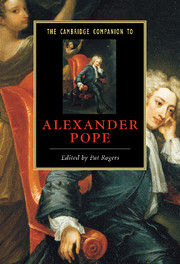Book contents
- Frontmatter
- Introduction
- 1 Pope, self, and world
- 2 Pope’s friends and enemies: fighting with shadows
- 3 Pope’s versification and voice
- 4 Poetic spaces
- 5 Pope’s Homer and his poetic career
- 6 Pope and the classics
- 7 Pope and the Elizabethans
- 8 Pope in Arcadia: pastoral and its dissolution
- 9 Pope and ideology
- 10 Pope and the poetry of opposition
- 11 Crime and punishment
- 12 Landscapes and estates
- 13 Money
- 14 Pope and the book trade
- 15 Pope and gender
- 16 Medicine and the body
- 17 Pope and the other
- Further reading
- Index
16 - Medicine and the body
Published online by Cambridge University Press: 28 April 2008
- Frontmatter
- Introduction
- 1 Pope, self, and world
- 2 Pope’s friends and enemies: fighting with shadows
- 3 Pope’s versification and voice
- 4 Poetic spaces
- 5 Pope’s Homer and his poetic career
- 6 Pope and the classics
- 7 Pope and the Elizabethans
- 8 Pope in Arcadia: pastoral and its dissolution
- 9 Pope and ideology
- 10 Pope and the poetry of opposition
- 11 Crime and punishment
- 12 Landscapes and estates
- 13 Money
- 14 Pope and the book trade
- 15 Pope and gender
- 16 Medicine and the body
- 17 Pope and the other
- Further reading
- Index
Summary
Alexander Pope's body, as most readers know, was severely deformed. Although he was trampled by a cow as a child of eight in a Berkshire field, as his sister reported (Anecdotes, i, pp. 3-4), his deformity sprang from an incurable tuberculosis of the spine, later called Pott's Disease, which produces curvature of the spine and a markedly humped back. By the time he entered puberty, he began to shrink rather than grow tall, eventually dwindling to no more than four and a half feet tall as an adult, and the fact that one leg was significantly shorter than the other caused him to develop his hump back. The protrusion was painful as well as noticeable, and in time forced him to walk with a stick (cane) and to wear specially fitted shoes. The accident he sustained as a child may also have contributed to genital difficulties he suffered from throughout his life: difficulty in urinating, painful testicles, and urethral pain so bad that he begged the surgeons for frequent operations to ease it. He also suffered from chronically poor eyesight, occasionally so acute that his parents and early doctors erroneously attributed his curved spine and humped back to excessive reading that wrecked his eyes. Voltaire epitomized him as “protuberant before and behind” and Pope himself later claimed that his “Crazy Constitution ” had amounted to “this long Disease, my Life.” He was prone to quipping, often disparagingly, about his miserable body which he likened to vermin and other small animals (especially to spiders and toads), and on one such occasion he referred to himself anonymously as “a lively little Creature, with long Arms and Legs: a Spider is no ill Emblem of him.”
- Type
- Chapter
- Information
- The Cambridge Companion to Alexander Pope , pp. 210 - 221Publisher: Cambridge University PressPrint publication year: 2007
- 1
- Cited by

